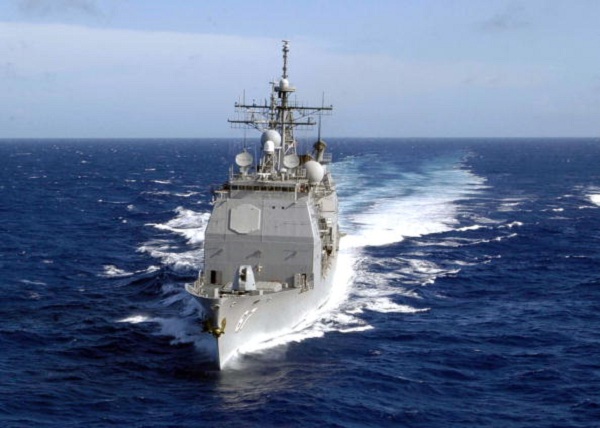US Launches Massive Naval Base and Weapons Program to Counter China's Presence in Asia-Pacific
| Carlos Castillo | | Dec 15, 2015 05:48 AM EST |
(Photo : US Navy via Getty Images/Patrick Bonafede) The US Navy's guided missile cruiser USS Shiloh is seen here patrolling the waters of the Western Pacific. US naval commanders are currently rewriting the US Navy's strategy on naval bases in the Asia-Pacific to counter China's presence in the region.
The US government has begun a massive program to rewrite its naval strategy in the Asia-Pacific in response to China's expanding naval presence in the region.
China's growing naval might, and Beijing's escalating efforts to enforce its claim over much of the South China Sea, have sent Washington's naval commanders scrambling to modernize the US Navy and revise the US agenda for naval bases in the region, according to a global foreign policy advisory organization.
Like Us on Facebook
Foreign Policy Magazine reports the US Navy's new program does not require large, permanent bases in the Asia-Pacific. Instead, it adopts a strategy that builds on the US Navy's access to a number of airfields scattered across the increasingly contentious area. These include several airbases in the Philippines under a landmark defense treaty currently being reviewed by the Philippine supreme court.
With US spy planes already operating in Japan, Singapore and the Philippines, US naval commanders are said to be considering additional naval facilities in the Pacific islands of Saipan and Tinian, over which the US has territorial claims.
Some 60 percent of the US Navy's entire fleet is expected to be deployed to the Asia-Pacific by 2020 under the new program, chiefly because China's growing presence in the area has alarmed US naval planners.
Washington insiders say the US Navy's new program came into being after the Pentagon realized that its Pacific fleet strategy had become obsolete, and could no longer guarantee minimal casualties in a conflict with China.
"Our military establishment came to this realization reluctantly," says former Pentagon senior official David Ochmanek. "The challenge is as much conceptual as it is hardware related."
Under the new program, US Navy Vice Admiral Thomas Rowden has called for more firepower across the Pacific, including arming logistics ships that are not usually equipped with weapons. In keeping with this order, the US Navy is currently arming the guided missile cruisers of the fleet with converted Tomahawk missiles, new AEGIS missile defense systems, state-of-the-art radar, and improved anti-submarine weapons.
"We are saving money, preserving force structure and generating options for leadership," Rowden said in a naval modernization ceremony held in California in September.
Funding the new strategy has apparently not been easy. In March, US chief of naval operations Admiral Jonathan Greenert complained to the US Senate committee on appropriations that budget shortfalls has forced the navy "to accept significant risks in key mission areas."
To remedy the problem, Greenert has submitted a hefty 2016 budget proposal for the US Navy. The proposed budget seeks, among other things, to increase US naval presence in the Asia-Pacific region.
Beijing does not conceal the fact that it is girding its navy to become a major maritime power. Foreign Policy Magazine reports that policymakers in China have allocated about a third of the country's $165 billion defense budget for its new classes of destroyers, cruisers, submarines and its first aircraft carrier.
The build-up has precipitated grim speculations from Washington's military analysts.
In a report issued last month for US lawmakers, Ronald O'Rourke of the US Congressional Research Service said China is building its naval capabilities to pursue two main objectives: to address its issues with Taiwan militarily, if need be; and to add muscle to its claims over the South China Sea.
TagsUS, US naval base, Philippine South China Sea Arbitration, Tomahawk, warship cruiser, Western Pacific, Asia Pacific, People's Liberation Army Navy
©2015 Chinatopix All rights reserved. Do not reproduce without permission
EDITOR'S PICKS
-

Did the Trump administration just announce plans for a trade war with ‘hostile’ China and Russia?
-

US Senate passes Taiwan travel bill slammed by China
-

As Yan Sihong’s family grieves, here are other Chinese students who went missing abroad. Some have never been found
-

Beijing blasts Western critics who ‘smear China’ with the term sharp power
-

China Envoy Seeks to Defuse Tensions With U.S. as a Trade War Brews
-

Singapore's Deputy PM Provides Bitcoin Vote of Confidence Amid China's Blanket Bans
-

China warns investors over risks in overseas virtual currency trading
-

Chinese government most trustworthy: survey
-

Kashima Antlers On Course For Back-To-Back Titles
MOST POPULAR
LATEST NEWS
Zhou Yongkang: China's Former Security Chief Sentenced to Life in Prison

China's former Chief of the Ministry of Public Security, Zhou Yongkang, has been given a life sentence after he was found guilty of abusing his office, bribery and deliberately ... Full Article
TRENDING STORY

China Pork Prices Expected to Stabilize As The Supplies Recover

Elephone P9000 Smartphone is now on Sale on Amazon India

There's a Big Chance Cliffhangers Won't Still Be Resolved When Grey's Anatomy Season 13 Returns

Supreme Court Ruled on Samsung vs Apple Dispute for Patent Infringement

Microsoft Surface Pro 5 Rumors and Release Date: What is the Latest?










